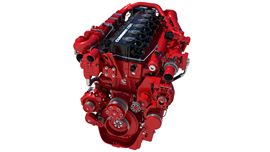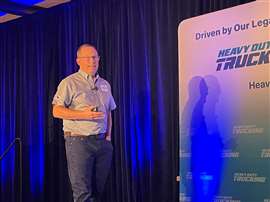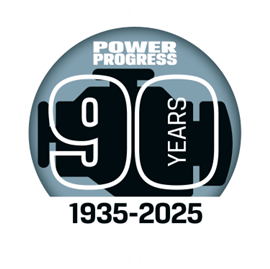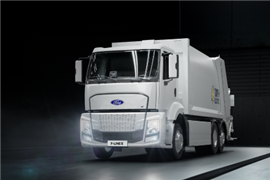09 October 2025
Way back in 2013, I was invited out to Cummins Westport in Vancouver, B.C. to test drive one of its 15 L natural gas truck engines. With all due respect to Cummins Westport, it remains the toughest day I’ve ever had on the job as a transportation journalist.
 Jack Roberts is a Tuscaloosa, Ala.-based independent journalist and licensed commercial driver with more than 20 years’ experience covering the North American and global trucking industries.
Jack Roberts is a Tuscaloosa, Ala.-based independent journalist and licensed commercial driver with more than 20 years’ experience covering the North American and global trucking industries.
That’s because I was headed to Boston Bar, a peak far up in the Cascade Mountains. And, oh yeah, I had a 140,000-lb. b-train behind me – with a manual gearbox, of course. (That is an important point, as we shall soon see.)
To be fair, the engine was completely up to the task. It produced 475 hp and churned out 1,750 ft.-lb. of torque, which was more than ample in the hands of an experienced driver well familiar with the truck, the route, b-trains and the powertrain.
Cummins Westport had specially selected such a difficult, demanding route precisely because they wanted to showcase the capabilities of its then-new natural gas-powered truck engines.
It was a tough drive for me. But I was still able to easily discern that natural gas truck engines held a lot of promise – even though they were somewhat of a novelty at the time.
Changing times
A lot has changed since 2013, of course.
Today, Cummins is the sole owner of that engine family, and the only manufacturer of natural gas truck engines in North America.
Plus, the unexpected market dominance of automated truck transmissions has vastly improved any performance issues those early natural gas engines had.
 Cummins is currently the only manufacturer of natural gas truck engines in North America. Shown is its X15N natural gas engine. (Photo: Cummins)
Cummins is currently the only manufacturer of natural gas truck engines in North America. Shown is its X15N natural gas engine. (Photo: Cummins)
Natural gas has a lower BTU (energy output) than diesel fuel, so those early engines were a bit underpowered. This was especially apparent when starting the truck moving with a manual gearbox, and even more apparent on long grades driving up into the Cascade Mountains.
Fleets have compiled millions of miles of reliable service with natural gas truck engines since then. The engines, and fuel, have become a mainstay in the refuse industry, for example.
Renewable natural gas – a cleaner version of what was already a pretty darn clean fuel to begin with – has also ramped up considerably over the past few years.
Natural gas engines have advanced to the point where they are a viable option for many long haul fleets in North America today. So why aren’t more of them out there on the road today?
A viable option
Mike Roeth, executive director of the North American Council for Freight Efficiency (NACFE), had some thoughts on the subject when he spoke at the Heavy Duty Truck Exchange Fleet Conference in Scottsdale, Ariz., on Sept. 4.
Roeth thinks that natural gas engines could scale into 10% to 15% of Class 8 day cabs over the next few years – and some sleeper models, as well.
 NACFE’s Mike Roeth speaks on trucking’s “Messy Middle” at the HDTX Fleet Conference in Scottsdale, Ariz., in September.
NACFE’s Mike Roeth speaks on trucking’s “Messy Middle” at the HDTX Fleet Conference in Scottsdale, Ariz., in September.
“The new Cummins X15N is lighter and has much more power and torque than previous engines,” Roeth noted. “It gets better fuel economy, as well. And Cummins engineers have done a fine job lowering the temperatures inside the engine significantly.”
Roeth said that several fleets currently participating in NAFCE’s Run on Less Messy Middle fleet trials are running natural gas engines, and they are reporting excellent metrics with the engines.
“Wegmans grocery stores in the Northeast will be an all-natural gas truck fleet early next year,” Roeth said. “They’re currently hauling double 53- and 48-ft. trailers in New York City without any issues.”
In Salt Lake City, Utah, Roeth said UPS is running doubles and triples over the mountains without difficulty. As is the Kleyson Group out of Edmonton, AB, which is hauling hazmat materials – including biofuels and renewable diesel – up into the Artic Circle.
In many ways, Roeth said, this is sort of a “reset” for natural gas engines in long haul applications. But he is optimistic that fleets will see a lot of benefits to the fuel when the final numbers are in.
“These fleets we’re working with are really going to work the hell out of these engines the next two or three years,” Roeth said. “And my guess is that once they’ve completed those trials, we’ll see that natural gas is a viable option for long haul fleets in the near future.”
POWER SOURCING GUIDE
The trusted reference and buyer’s guide for 83 years
The original “desktop search engine,” guiding nearly 10,000 users in more than 90 countries it is the primary reference for specifications and details on all the components that go into engine systems.
Visit Now
STAY CONNECTED




Receive the information you need when you need it through our world-leading magazines, newsletters and daily briefings.
CONNECT WITH THE TEAM












